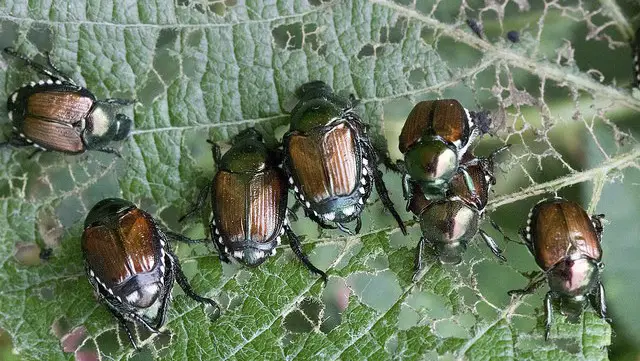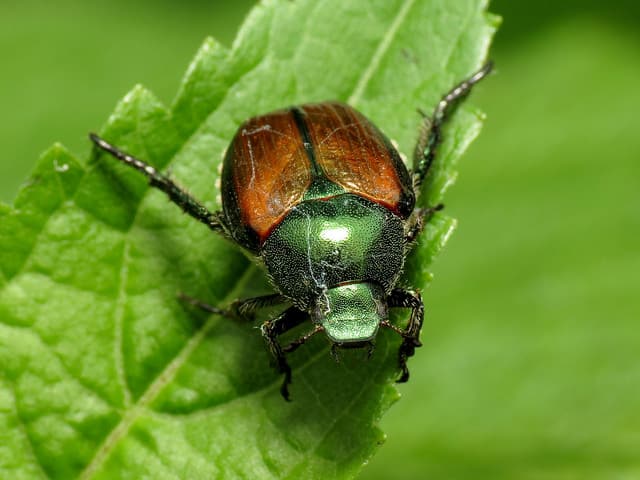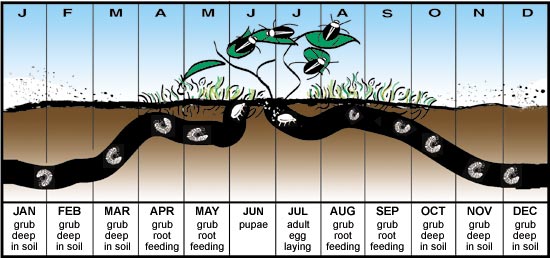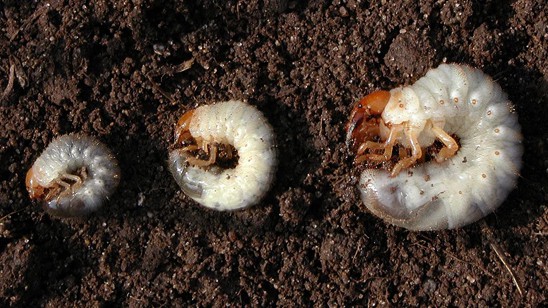A real nuisance in the garden, Japanese Beetles bothers many gardeners in the US, and it’s no wonder because the pest’s menu consists of about 300 common plant species. If you’re troubled by this annoying pest, read on to learn how to get rid of it.

What Is The Japanese Beetle?
The Japanese Beetle (Popillia japonica) is a species of scarab beetle, known for its distinctive metallic blue-green head, copper back, and white hairs under the wings. It can grow 0.6 inches (15 mm) in length and 0.4 inches (10 mm) in width.
Although native to Japan, the pest is not as nearly destructive as in America. It was originally found only throughout the Japanese islands, where it has been controlled by natural predators, but it was accidentally brought to the US at the beginning of the century. Since then, the Japanese Beetle has been a severe and devastating pest across the US and later Canada. With no effective predators and with vast land space and favorable climate, the Japanese beetle has found its new home.

The pest is not a choosy eater – the adult consumes more than 300 plant spices, frequently causing severe damages to common crops: tomato, bean, grape, rose, cherry, strawberry, pepper, peach, pear, blackberry, blueberry, corn, pea, and okra. Their activity starts in June when they usually attack host-plants in groups.
What Is The Lifecycle of The Japanese Beetle?
So, you’ve probably noticed small, white balls in your garden’s soil? These are the larvae of scarab beetles; an immature form also called a white grub.
As soon as the adult beetle emerges from the ground, it lays eggs near the soil surface, and after approximately 2 weeks, the eggs are hatched. This is when larvae start feeding on organic materials in the soil.

Photo: University of Michigan
As they grow, they become C-shaped grubs that feed on vegetable seedlings and roots of turf-grass, causing a damage to lawns and early stages of crops. The beetle stays in the immature form for 10 months, overwintering in the grub stage. When temperatures start to fall, they go deeper in the ground, but as soon as spring arrives, they move up to the root zone. Within 4-6 weeks, the grubs pupate in an earthen cell and remain until they emerge from the ground. And the cycle starts all over again.
How to Get Rid of The Japanese Beetle and White Grubs?

When fighting this serious pest, it’s important acknowledging that both an adult and immature form are dangerous.
There are several ways to control the Japanese beetle and white grubs while protecting your established plants:
- Japanese Beetle Traps
The common commercial solution for Japanese beetles infestation are the traps that contain pheromones attractive to beetles. But, research suggests that these traps sometimes cause an additional problem, bringing the large group of beetles to the area.
The scent really does attracts beetles, but susceptible plants in the vicinity can suffer serious damage. Many experienced gardeners agree that these traps do more harm than good. Unless you have a spot for traps away from host-plants, or if the infestation is treated systematically on the large area, the results might be modest or even worse. - Neem Oil
Neem oil is said to work effectively against the Japanese Beetle. It contains potassium bicarbonate that once is ingested by the adult, it affects their eggs, causing the larvae to die before going mature. - Milky Spore
During the larvae stage, the beetles are susceptible to fatal fungal disease caused by the bacteria called milky spore. The milky spore powder, purchased in stores, can be applied to the infested area. - Nematodes
Parasitic nematodes (Heterorhabditis spp.) pray on Japanese beetles, so you can add them to the soil in late August or early September. - Homemade Insecticide
Even a natural, homemade insecticide could harm your plants, so be careful. Use a tablespoon of liquid dishwashing detergent and a cup of vegetable oil. Shake it properly and then add it to a ¼ gallon of water. Afterward, add a cup of rubbing alcohol and shake once again. Spray the solution on the infected plants every morning during the 10-day period. - Chemical Treatment
Many chemical-based insecticides are labeled for use against adult Japanese beetles. Some of the most effective insecticides include: pyrethroid-based products such as cyfluthrin (Tempo, Bayer Advanced Lawn & Garden Multi-Insect Killer), permethrin (Spectracide Bug Stop Multi-Purpose Insect Control Concentrate and other brands) bifenthrin (Talstar One, Onyx), deltamethrin (Deltagard), lambda cyhalothrin (Scimitar, Spectracide Triazicide), esfenvalerate (Ortho Bug-B-Gon Garden & Landscape Insect Killer) and carbaryl (Sevin and other brand names). But before you use an insecticide, check up on approved insecticides in your area. - Manual Removal
If the infestation is not large, you can try to psychically remove adult beetles. You can wrap a duct tape around your fingers with a sticky side out, so the beetles would glue onto it, instead of falling to the ground. Collect them in a cup with diluted soap, so once they’re trapped they drown in the soap solution. Be sure not to crush them, because the smell could attract others to your garden.
How to Prevent Japanese Beetles?
Plan Your Landscape
If you live in an area infested by Japanese Beetles, you could carefully plan your landscape, avoiding plants preferred by adult beetles. That list, unfortunately, includes roses, Japanese and Norway maple, sassafras, birch, grape and many more. On the other hand, you can choose many plants and trees less susceptible to the Japanese beetle attacks. These are Red and Silver maple, common pear, various species of oak, magnolia etc.
Companion Planting
Some plants like garlic, tansy, chives, catnip or rue, repel these pests, so include them in your garden near the plants that attract the beetles.
Use Geraniums
Japanese beetles just love geraniums, so use them as a sort of trap. You can plant them near the more valuable plant or tree you’d like to protect.